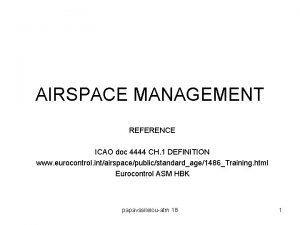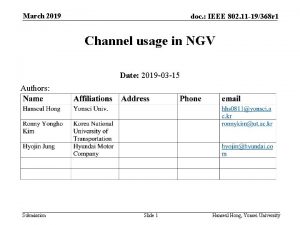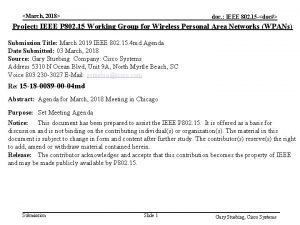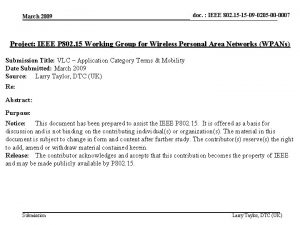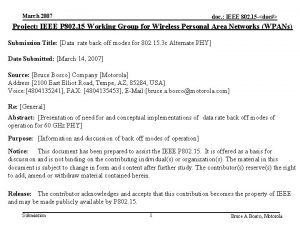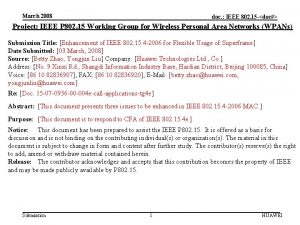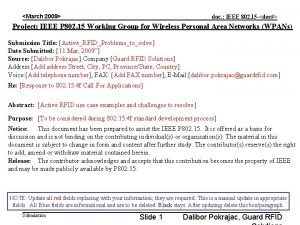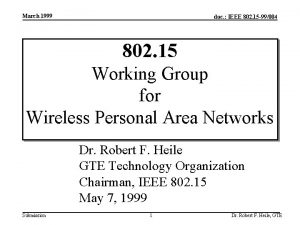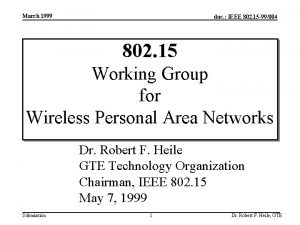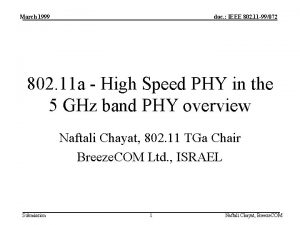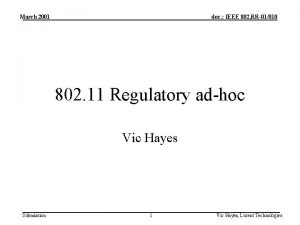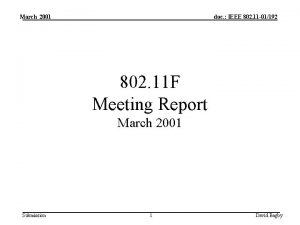March 2019 doc IEEE 802 11 19368 r











![March 2019 doc. : IEEE 802. 11 -19/368 r 0 Reference [1] 18/861 r March 2019 doc. : IEEE 802. 11 -19/368 r 0 Reference [1] 18/861 r](https://slidetodoc.com/presentation_image_h2/7c0f8d126f716cef57332b60675b2146/image-12.jpg)


- Slides: 14

March 2019 doc. : IEEE 802. 11 -19/368 r 0 Channel usage in NGV Date: 2019 -03 -12 Authors: Submission Slide 1 Hanseul Hong, Yonsei University

March 2019 doc. : IEEE 802. 11 -19/368 r 0 Introduction • As in PAR document[1], the 11 bd operation in V 2 X communication shares the channel with 11 p devices, maintaining interoperability – This amendment shall provide interoperability, coexistence, backward compatibility, and fairness with deployed OCB (Outside the Context of a BSS) devices. • When the number of nodes increases, the channel access mechanism cannot ensure the reliability of the communication because of the channel capacity limitation • In this contribution, the channel access performance for the case of periodic BSM message transmission is investigated, as the number of nodes increases. Submission Slide 2 Hanseul Hong, Yonsei University

March 2019 doc. : IEEE 802. 11 -19/368 r 0 Channel usage in DSRC • According to the FCC regulation[3], in the DSRC communication based on IEEE 802. 11 p, each channel in 5. 9 GHz band assigned for V 2 X communication utilizes 10 MHz bandwidth – The BSM message is sent in Ch 172, which is dedicated for safety message Ch 172 SCH safety Ch 174 Ch 176 SCH: may used in 20 MHz Ch 178 CCH Ch 180 Ch 182 SCH: may used in 20 MHz Ch 184 SCH safety • In this contribution, it is assumed that 11 bd devices also transmit BSM messages using the same channel as 11 p devices. Submission Slide 3 Hanseul Hong, Yonsei University

March 2019 doc. : IEEE 802. 11 -19/368 r 0 Channel capacity limitation in dense scenario • In case of the large number of cars, BSMs sent by each node may cause congestion in the single 10 MHz channel – The dense environment includes traffic jam, intersection and tollgate scenarios Submission Slide 4 Hanseul Hong, Yonsei University

March 2019 doc. : IEEE 802. 11 -19/368 r 0 Contention-based MAC access for highly congested channel • When the channel is congested, the contention-based MAC channel access mechanism causes the large collision probability. • The transmission procedure of BSM messages, which is a broadcast message without retransmission, does not guarantee the reliability of the transmission. Submission Slide 5 Hanseul Hong, Yonsei University

March 2019 doc. : IEEE 802. 11 -19/368 r 0 Brief analysis of collision probability in contention-based channel access • In order to investigate how large number of nodes affects the reliability, brief simulation is performed. • Assumptions – perfect channel – channel access with legacy DCF parameters – only BSM messages with 100 ms period Submission Parameter Values BSM size (including Header) 400 Bytes Number of nodes 10~200 AIFSN 2 min. CW 15 MCS Slide 0/2 6 Hanseul Hong, Yonsei University

March 2019 doc. : IEEE 802. 11 -19/368 r 0 Collision probability of BSM messages in single 10 MHz channel • For 400 Bytes BSM message with MCS=0 – Collision probability of more than 0. 1 occurs in case of more than 70 nodes • For 95% reliability, the number of nodes should be less than 60, for idle channel • For 99% reliability, the number of nodes should be less than 40, for idle channel Submission Slide 7 Hanseul Hong, Yonsei University

March 2019 doc. : IEEE 802. 11 -19/368 r 0 Collision probability of BSM messages in single 10 MHz channel • For 400 Bytes BSM message with MCS=2 – Collision probability of more than 0. 1 occurs in case of more than 120 nodes • For 95% reliability, the number of nodes should be less than 100, for idle channel • For 99% reliability, the number of nodes should be less than 40, for idle channel Submission Slide 8 Hanseul Hong, Yonsei University

March 2019 doc. : IEEE 802. 11 -19/368 r 0 Observation • Even with only BSM messages in the channel, the contention-based channel access in single channel does not guarantee the reliability required for safety operation – Reliability cannot be achieved in dense environments, such as heavy traffic (e. g. traffic jam), platooning scenario, and highly populated places like intersection or tollgate. • For other environments, the number of nodes meeting the reliability requirements will be decreased – When channel switching is applied, the collision probability will be increased, as described in [4] – When the other messages sent in the channel(warning signal, etc), the collision probability will be increased Submission Slide 9 Hanseul Hong, Yonsei University

March 2019 doc. : IEEE 802. 11 -19/368 r 0 Discussion • As the reliability issue arises in the dense scenario, the modification of the channel access procedure, as well as channel switching mechanism are needed – Modification shall not affect backward compatibility and interoperability with legacy devices – Modification shall work under OCB environment • Higher MCS or wider channel bandwidth may lower the collision probability, but the transmission range requirement may not be satisfied. • Distributed multi-user operation may be required to enhance the channel efficiency. – Based on distributed 802. 11 ax OFDMA or Distributed PCF Submission Slide 10 Hanseul Hong, Yonsei University

March 2019 doc. : IEEE 802. 11 -19/368 r 0 Conclusion • In this presentation, we investigated the channel access performance used in 11 p, especially for BSM messages in 10 MHz channel • Even though a dedicated 10 MHz channel is allocated for BSM messages, the reliability of BSM transmissions cannot be achieved as the number of nodes increases. • The conventional channel access method is not enough to achieve the reliability requirements in dense environment • In 802. 11 bd, efficient distributed multi-user channel access methods are required to accommodate more vehicles. Submission Slide 11 Hanseul Hong, Yonsei University
![March 2019 doc IEEE 802 11 19368 r 0 Reference 1 18861 r March 2019 doc. : IEEE 802. 11 -19/368 r 0 Reference [1] 18/861 r](https://slidetodoc.com/presentation_image_h2/7c0f8d126f716cef57332b60675b2146/image-12.jpg)
March 2019 doc. : IEEE 802. 11 -19/368 r 0 Reference [1] 18/861 r 9 IEEE 802. 11 NGV SG Proposed PAR [2] 17/651 r 2 Indication for WUR Duty Cycle [3] Electronic Code of Federal Regulations [4] L. Miao, et. al. , Performance Evaluation of IEEE 802. 11 p MAC Protocol in VANET Safety Applications, 2013 IEEE Wireless Communications and Networking Conference (WCNC), Shanghai, 2013, pp. 1663 -1668. [5] J. B. Kenney Dedicated Short-Range Communication (DSRC) Standards in the United States Submission Slide 12 Hanseul Hong, Yonsei University

March 2019 BACKUP Submission doc. : IEEE 802. 11 -19/368 r 0

March 2019 doc. : IEEE 802. 11 -19/368 r 0 Collision probability for BSM in single 10 MHz channel • When assuming 300 Bytes of BSM in MCS=0 – Over the 10% collision occurs in case of more than 90 nodes • For 95% reliability, the number of nodes should be less than 70, for idle channel • For 99% reliability, the number of nodes should be less than 40, for idle channel Submission Slide 14 Hanseul Hong, Yonsei University














